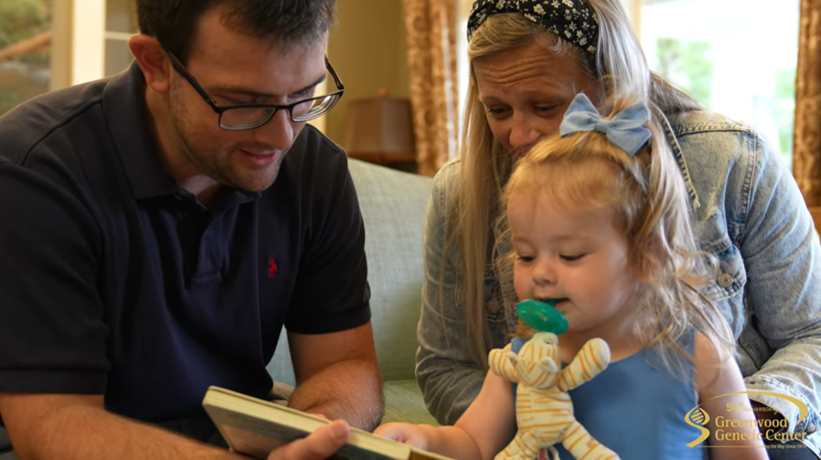
John Gallagher loved baseball, especially the Minnesota Twins. He was a whiz with technology, an avid bowler, and a passionate supporter of veterans. He also advocated for those with disabilities, meeting with state senators and legislators. He did so, because he was affected with a rare genetic disorder himself, Snyder-Robinson syndrome. John’s family was the first to be identified with this ultra-rare disorder in 1969, when John was just 10 years old. To date, only 50 individuals worldwide have been diagnosed with Snyder-Robinson syndrome.
Snyder-Robinson syndrome (SRS) is a rare genetic disorder, affecting only males, that causes intellectual disability, muscle and bone abnormalities, and distinctive facial features such as cleft palate, a prominent lower lip and asymmetry of the face. Affected males can also have seizures and kidney issues.
In 2003, researchers, led by Dr. Charles Schwartz at the Greenwood Genetic Center, identified the gene responsible for SRS. Since then, GGC has become the leading center for the study of the disorder.
The SRS gene produces an enzyme called spermine synthase. If the gene is altered and the enzyme is deficient, there will be a lack of a polyamine compound called spermine in cells. Polyamines, like spermine, are vital for the normal development and function of the brain and other body tissues.
As the understanding of the basis of this rare disease has emerged, scientists are now focused on treating the condition. In December 2017, GGC convened and hosted a workshop in Greenwood, SC in association with the Snyder-Robinson Foundation. Participants in the workshop included nationally-recognized basic scientists, physicians who work with patients with SRS, representatives of companies interested in developing therapeutics, and leaders from the SRS Foundation representing the interests of families.
The group, referred to as the ‘Polyamigos’, for their expertise in polyamines and dedication to collaboration, discussed how to advance research and explored several avenues for the treatment of SRS.
“We are looking at multiple treatment options including utilization of a drug with a structure similar to spermine or a better way to deliver spermine into the cells,” said Schwartz. “We also discussed the potential for gene therapy to provide the normal enzyme to the cells, as well as reviewed data that indicates the possibility of using certain drugs that, although they won’t cure SRS, may help ameliorate some of the symptoms.”
Michael Raymond was one of the workshop participants. Raymond is the Executive Director of the Snyder-Robinson Syndrome Foundation and father to a 10 year old son with SRS. “My son, Connor, was diagnosed with SRS at age 5 and a half after an exhausting search for answers. He was evaluated by countless doctors, including at least eight geneticists at four institutions before his mutation was identified,” said Raymond.
Connor’s mother, Katia Luedtke, who serves as the Legal Counsel and Secretary for the SRS Foundation, shared, “Not knowing what your child suffers from is, I believe, more painful than finding out that he has an ultra-rare genetic syndrome for which there is no cure. We now have something to focus on to be able to help our son.”
At the workshop, John Gallagher, who passed away in October at the age of 58, was honored, and it was shared that his final wish was to donate his organs to research to help others including his affected brothers and nephews. Researchers plan to examine the donated organs through a lab at Michigan State to better understand how spermine deficiency affects each tissue.
“John lived his life full of faith, hope, and charity to all,” said his brother, Daniel Gallagher. “His life touched all those who knew him, and now, with this gift, he will continue to touch lives for generations to come.”
Luedtke echoed those sentiments, “Words seem insufficient to adequately capture the magnitude of the gift John gave to SRS research. His legacy is a great one and we will do our best to honor his memory with our efforts to find a cure or treatment for SRS.”
The workshop concluded with a renewed effort for the group to collaborate and pursue various funding opportunities in order to move forward with approaches that might treat SRS.
“This was a unique opportunity for those of us in this area of study to gather and focus intently on our ultimate goal and how we can best get there,” said Schwartz. “Through our work we have also created a roadmap of how a small group of scientists and stakeholders, focused on a single syndrome, can advance the treatment of SRS and other rare syndromes.”
With the collaborative spirit of the Polyamigos and the generosity of John Gallagher and his family, Connor’s family has found a renewed hope.
“The ability to gather such brilliant scientists, doctors and researchers together to brainstorm with their collective knowledge is unprecedented in the rare disease world,” said Luedtke. “When your child’s rare disease is 1:150,000,000, it is truly astounding that this event came together with such promising results.”
Visit The Gene Scene, GGC’s blog, to learn more about the stories of Connor Raymond and John Gallagher.
Seated L-R: Charles Schwartz, PhD, Greenwood Genetic Center; Teri Koerner, Snyder-Robinson Foundation; Mary Jo Kutler, Snyder-Robinson Foundation; Angela Peron, MD, University of Milan; and Bob Casero, PhD, Johns Hopkins School of Medicine.
Standing L-R: Aamir Zuberi, PhD, The Jackson Laboratory; Michael Raymond, Snyder-Robinson Foundation; Tony Pegg, PhD, Penn State University School of Medicine; Colin Nichols, PhD, Washington University; Garce Zhai, PhD, University of Miami Miller School of Medicine; Chong Li, University of Miami Miller School of Medicine; Otto Phansteil, PhD, University of Central Florida; Gene Gerner, PhD, Cancer Prevention Pharmaceuticals; Andre Bachmann, PhD, Michigan State University; and Roger Stevenson, MD, Greenwood Genetic Center. Not pictured: Mark Burns, PhD, Aminex Therapeutics, Inc.
